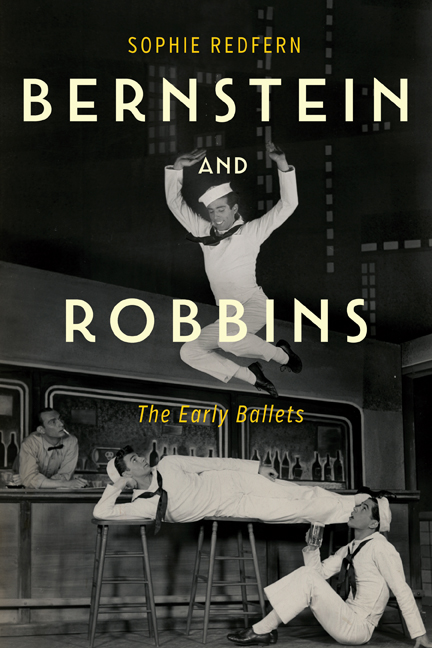Book contents
- Frontmatter
- Dedication
- Contents
- List of Illustrations
- Acknowledgments
- List of Abbreviations
- Editorial Note
- Preface
- 1 Setting the Scene: American Ballet and Jerome Robbins
- 2 Toward a First Ballet: Fancy Free Takes Shape
- 3 Creating Fancy Free: A Long-Distance Collaboration
- 4 The Music of Fancy Free: The Sketches and Score Explored
- 5 The Fancy Free Premiere and a Move to Broadway
- 6 Toward a Second Ballet: Bye Bye Jackie and the Creation of Facsimile
- 7 The Music of Facsimile: The Sketches and Score Explored
- 8 The Facsimile Premiere and Legacy of the Ballets
- Epilogue: Bernstein and Dance
- Bibliography
- Index
4 - The Music of Fancy Free: The Sketches and Score Explored
Published online by Cambridge University Press: 23 March 2021
- Frontmatter
- Dedication
- Contents
- List of Illustrations
- Acknowledgments
- List of Abbreviations
- Editorial Note
- Preface
- 1 Setting the Scene: American Ballet and Jerome Robbins
- 2 Toward a First Ballet: Fancy Free Takes Shape
- 3 Creating Fancy Free: A Long-Distance Collaboration
- 4 The Music of Fancy Free: The Sketches and Score Explored
- 5 The Fancy Free Premiere and a Move to Broadway
- 6 Toward a Second Ballet: Bye Bye Jackie and the Creation of Facsimile
- 7 The Music of Facsimile: The Sketches and Score Explored
- 8 The Facsimile Premiere and Legacy of the Ballets
- Epilogue: Bernstein and Dance
- Bibliography
- Index
Summary
The Sketches
The correspondence between Bernstein and Robbins goes some way to revealing the process by which Bernstein composed Fancy Free: the letters detail the practicalities of where and how he was working, the constant discussions and negotiations he was undertaking with Robbins, and the pressure he was under as the first performance approached. It is, however, the surviving music manuscripts—autograph sketches, autograph fair copies on transparency (sometimes with insertions in a copyist's hand), and an autograph orchestral score—which, when used alongside the rehearsal recordings and published orchestral score, allow a deeper understanding of how Bernstein composed the work. This chapter explores sketches for three of the most notable musical scenes—“Big Stuff,” the Three Dance Variations, and the Finale—to reveal the origins of the musical material, the motivation for including certain passages, and the impact of Robbins and others on the resulting score.
It is worth noting that while most of the autograph sources were kept by Bernstein and so are in the Leonard Bernstein Collection (LBC), of great interest are duplicates of the autograph fair copies that were sent to Robbins and now form part of the Jerome Robbins Personal Papers (JRPP). When Robbins received a manuscript and wanted cuts, Bernstein sometimes made them in the most literal sense, by physically cutting the sections out of the score with scissors or a knife. As such, the composer's personal copies include holes and there are pages missing, meaning that, despite being autograph manuscripts, they are later versions of the scenes. In contrast, the “duplicates” Robbins possessed are the only surviving record of the first versions of scenes.
A Note on the Order of Composition
Bernstein worked from Robbins's scenario: it dictated the style and mood Bernstein was required to convey through his music, it gave him a clear outline of the action, and it provided the structure. No surviving letters or notes show whether Robbins initially asked for scenes to be composed in any particular order, but as Bernstein was originally given a January 1 deadline for the whole score this was not an immediate concern. The plan was for Robbins to have four months to choreograph and rehearse the ballet after the complete score was received.
- Type
- Chapter
- Information
- Bernstein and RobbinsThe Early Ballets, pp. 97 - 150Publisher: Boydell & BrewerPrint publication year: 2021

